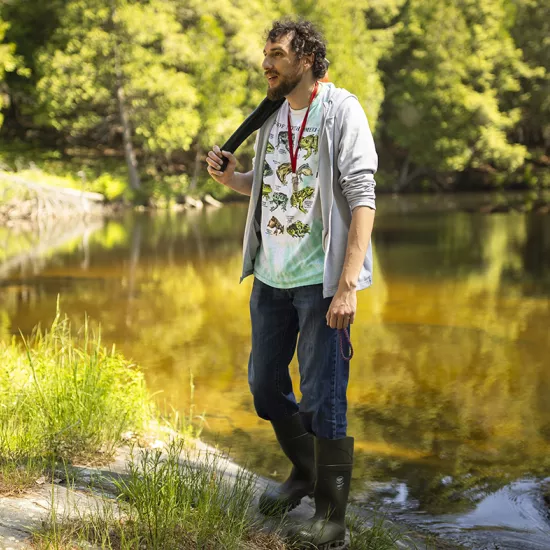Robert Reisz


A strange thing happened when Professor Robert Reisz attempted to earn a degree in physics in the mid-1960s. “I hated it” Reisz cringes. “In high school physics was really fascinating, but in university it was just awful and dull.”
Reisz then felt uncertain about what educational direction to pursue. His parents encouraged him to “go to medical school, young man,” but he wasn’t thrilled about that idea either, so he set out to find something that would interest him. After taking various courses at McGill in music and philosophy and several in biology, his curiosity was piqued by a course being offered on fossils. “I took it, and just loved it, and…that was it,” says Reisz. He completed his studies at McGill, and worked at UCLA for a year before accepting a faculty position at the University of Toronto Mississauga in 1975. Today he is Chair of the Biology Department, a world renowned vertebrate paleontologist, and this year he is the recipient of the prestigious Alexander von Humboldt Research Award.
Focusing mainly on extinct vertebrates in his research, Reisz is particularly interested in the evolutionary consequences of the invention of the amniotic egg, which originated 315 million years ago (MYA). “The amniotic egg has a large amount of yolk and a series of structures called extra-embryonic membranes,” explains Reisz. “This innovation allowed animals to lay relatively few eggs and invest a lot of energy in those eggs, and allowed them to separate themselves completely from reproduction in the water.” Reisz says that animals did come on land prior to this time but had to go back into the water to reproduce, however with the advent of the amniotic egg, they were able to become fully terrestrial. Reisz is fascinated by this time period because of the great expansion of terrestrial vertebrate life that is superbly reflected in the fossil record.

Reisz and his research team attempt to piece together a clearer picture of what these animals looked like, how they behaved, who their relatives and descendants are, and then reconstruct their evolutionary history. Reisz points out that 310-305 MYA all the terrestrial vertebrate life was on one large supercontinent called Pangaea, and that the animals have been found along the equator, which extended from New Mexico, Texas, Nova Scotia, England and central Europe. At this time there was also a huge ice age that covered most of the southern part of the supercontinent, freezing up South America, Africa, India and Antarctica, but when the ice age ended the faunas appear to have spread everywhere. “So I’m going all over the world looking for these fossils,” says Reisz. “I have studied material from North America, Europe, Russia, South Africa, and I’m currently working on material
from India.”
While Reisz’s research projects have taken him around the globe, there is one quarry in Fort Sill, Oklahoma, that has been particularly fruitful in fossil finds. Reisz started out his vertebrate paleontology career at this site (he went there in the third year of his undergraduate degree), has returned many times since, and has approximately two dozen papers that have research based on this one locality. The limestone quarry, at which the discovery of fossils dates back to the 1930s, makes crushed rock but also preserves ancient caves. “This quarry has produced the richest and most diverse fauna in this initial stage of terrestrial vertebrate evolution,” says Reisz. Considering most major museums have material from this quarry, Reisz refers to it as the “mother lode of all fossil localities,” noting that 37 different animals have been discovered at this site alone, and that its supply of fossil treasures seems endless.
With the various projects Reisz has tackled or collaborated on over the years, pinpointing one favorite is a challenge. “Really exciting and interesting research projects have come serendipitously my way,” says Reisz. Although not directly related to his research, he cites the work he did in 2001 on lungfish that enabled him to identify a dental developmental pattern that spans 360 million years. Reisz also mentions the South African dinosaur-embryo project that came his way in 2005: Reisz led the team that studied the 190-million-year-old fossilized embryos of Massospondylus, a plant-eating dinosaur from the Jurassic period. Another significant highlight for Reisz was research on Petrolacosaurus that he completed for his PhD. The 305 million year old animal turned out to be the oldest known diapsid reptile – a group that includes all dinosaurs, crocodiles, birds, lizards and snakes. This was one of Reisz’s first papers published in the prestigious academic journal Science in 1977.

With important projects spanning thirty years and around the world, it is fitting that Reisz received the Humboldt Research Award, which annually honors internationally recognized scientists and scholars from abroad for career-long achievements in research and teaching. As part of the award, Reisz will be given the opportunity to pursue a research project of his own design in Germany, working with appropriate colleagues for a period of eight months. Reisz has chosen to study the origin of turtles and his work will be carried out at the Stuttgart Museum of Natural History. “We’re going to actually look at the oldest turtles with some modern techniques and devices, such as CAT sans and laser scanning, for doing what we call morphometrics, which measures the precise shell shape, rather than just looking at it or studying it” explains Reisz. He is also looking forward to having access to Germany’s Trossingen Quarry, which is a classic locality that has yielded fossils of turtles and relatives of the dinosaur embryos that Reisz studied, and it will be reopened specifically for this project.
Although the information-dense world of the Carboniferous and Permian periods of paleontology can get pretty heavy, Reisz knows how to inject a bit of humor into the mix. On his website he has a section on research methodology, which provides “a look at the long and occasionally tedious process of discovering, preparing, analyzing, and finally documenting vertebrate fossils.” Among the headings, which include “Think of a question worth investigating” and “Describe and illustrate the specimens,” he concludes with “Have a party.” Reisz makes the observation that “science educators at all levels often fail to tell their students about this crucial part of the scientific method…” For this avid Bridge player and self-proclaimed “science-fiction freak,” who reads every sci-fi book available, the chance to joke with friends or laugh at some of the lousy science-fiction films that he sees (“they’re so bad that they’re funny”) is an important outlet.
Having started out with not much direction, Reisz has managed to carve out his life-work that has proven to be inspiring, rewarding and even pleasurable for him. He considers his research to be a career-long approach to vertebrate paleontology, and he is always looking forward to the next project and the discoveries that might be unearthed. “It’s a mystery; it’s observational science,” says Reisz. “But then you put it together to present a cool story – and that’s where the fun is.”



